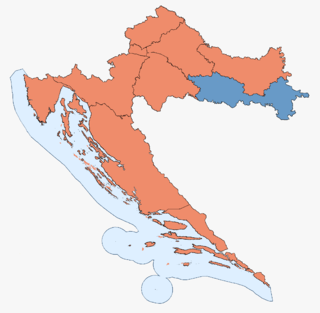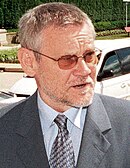Croatian parliamentary election, 2000
|
|
|||||||||||||||||||||||||||||||||||||||||||||||||||||||||||
|---|---|---|---|---|---|---|---|---|---|---|---|---|---|---|---|---|---|---|---|---|---|---|---|---|---|---|---|---|---|---|---|---|---|---|---|---|---|---|---|---|---|---|---|---|---|---|---|---|---|---|---|---|---|---|---|---|---|---|---|
|
|||||||||||||||||||||||||||||||||||||||||||||||||||||||||||
|
All 151 seats to Chamber of Representatives 76 seats needed for a majority |
|||||||||||||||||||||||||||||||||||||||||||||||||||||||||||
| Turnout | 70.5% | ||||||||||||||||||||||||||||||||||||||||||||||||||||||||||
|
|||||||||||||||||||||||||||||||||||||||||||||||||||||||||||

Results of the election in each of the ten electoral districts of Croatia: the party with the majority of votes in each electoral unit.
SDP-HSLS coalition: red; HDZ: blue |
|||||||||||||||||||||||||||||||||||||||||||||||||||||||||||
|
|||||||||||||||||||||||||||||||||||||||||||||||||||||||||||
| 1992 election • MPs |
| 1995 election • MPs |
| 2000 election • MPs |
| 2003 election • MPs |
Parliamentary elections for the Chamber of Representatives of the Croatian Parliament were held on 3 January 2000. These were the first elections to be held after the expiration of a full 4-year term of the previous Chamber of Representatives.
The ruling Croatian Democratic Union entered the elections weakened by the Zagreb Crisis, street protests and the series of corruption scandals that came to light in the previous parliamentary term. However, the most important factor was the deteriorating health of the party leader and Croatian president Franjo Tuđman, which sparked a succession struggle between various factions within the party.
On the other side, two major Croatian opposition parties - the Social Democratic Party of Croatia and Croatian Social Liberal Party - had their coalition formally agreed in 1998 and spent more than a year preparing for the elections. At first, they were to run together with the Croatian Peasant Party, Croatian People's Party, Istrian Democratic Assembly and Liberal Party, but as Tuđman's condition worsened leaders of the SDP and HSLS concluded that they could win elections even without those four other parties which later formed a separate bloc.
Like before all previous elections since the breakup of Yugoslavia, the electoral laws were altered in an attempt to improve the chances for the ruling party; this included a new voting system and redistricting. The First Past the Post constituencies introduced in the previous election were completely abandoned and Proportional Representation was implemented (with the exception of single representative ethnic minority seats). Croatia was divided into ten electoral districts, all drawn in order to maximise the support for HDZ. Each district had to elect 14 members, with candidates' lists having to win more than 5% of the votes in order to be represented in the Sabor.
...
Wikipedia


